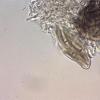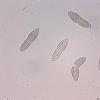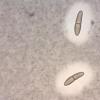
02-12-2025 18:59
This pair of ascos 2.5cm across were on recently b

02-12-2025 19:25
Buckwheat PeteHello, can anyone identify this hairy fungus growi

30-11-2025 12:53
 Edvin Johannesen
Edvin Johannesen
White short-stipitate apothecia found on thin twig

30-11-2025 10:47
 William Slosse
William Slosse
I recently found a collection of small Peziza sp.

27-11-2025 12:01
Thomas Læssøehttps://svampe.databasen.org/observations/10496727

27-11-2025 11:46
Thomas Læssøehttps://svampe.databasen.org/observations/10493918

17-09-2025 10:50
Heather MerryleesHi there!I am hoping for any advice on the identif

29-11-2025 08:40
 Andreas Millinger
Andreas Millinger
Hello,on a splintered part of a branch on the grou

28-11-2025 16:45
Nogueira HéctorNovember 23, 2025 Requejo de Sanabria (León) SPAI
I found this bitunicate ascomycete growing on dead leaves of Eriophorum angustifolium.
Pseudothecia are immersed, ca 100-150 µm diam
Asci are bitunicate, ovoid, 8-spored, 38-57 x 22-29 µm (only 2 asci measured). Sometimes immature and post-mature asci are present in the same pseudothecium.
Spores are mostly 22-25 x 5-6(-7) µm, in one sample rather larger (<31 µm long). They are 1-septate, slightly constricted at septum, and sometimes splitting at the septum into 2 parts. Spores are hyaline, becoming dark brown when old, with 2 large oil bodies/cell when fresh, and with a thick gelatinous sheath. The spore wall appears to be minutely verruculose in old spores.
I think it belongs in the Pseudosphaeriaceae. I had wondered about Monascostroma innumerosum but the thick gelatinous spore sheath seems to rule out this species and suggests Wettsteinina. The closest fit in Shoemaker & Babcock's 1987 paper on Wettsteinina is probably W. junci, but the description doesn't fit in all respects, e.g. spore dimensions are given as 26-31 x 9-11 µm (i.e. rather larger than in my specimen). Another possibility is W. waltraudae, described by Scheuer and not included in Shoemaker & Babcock.
I'd be grateful for any suggestions.
Thanks
Marcus




